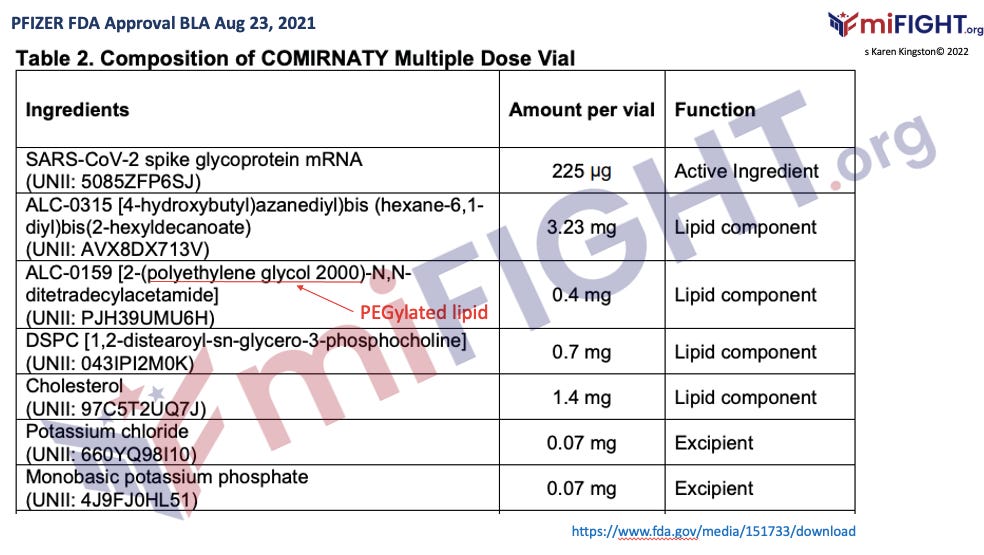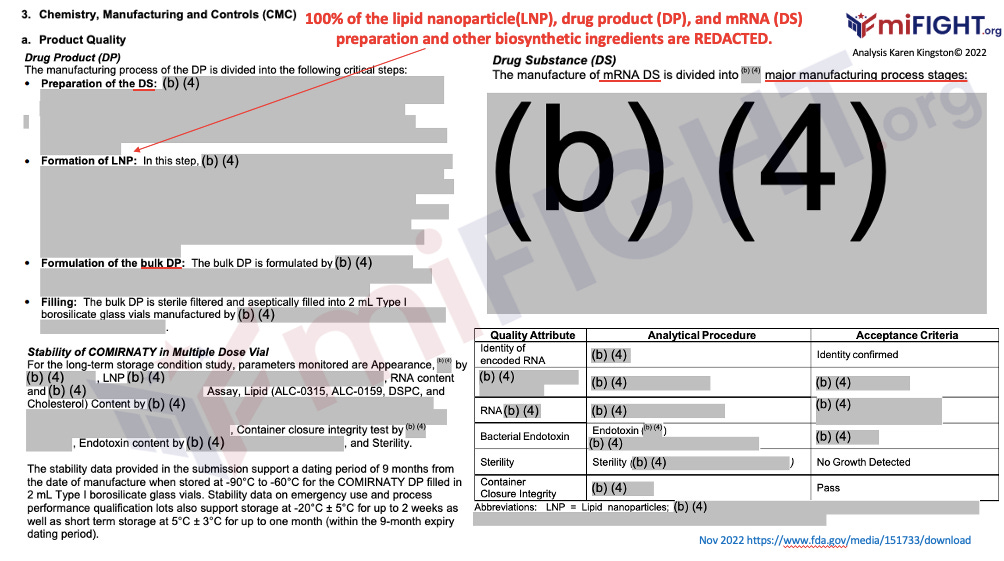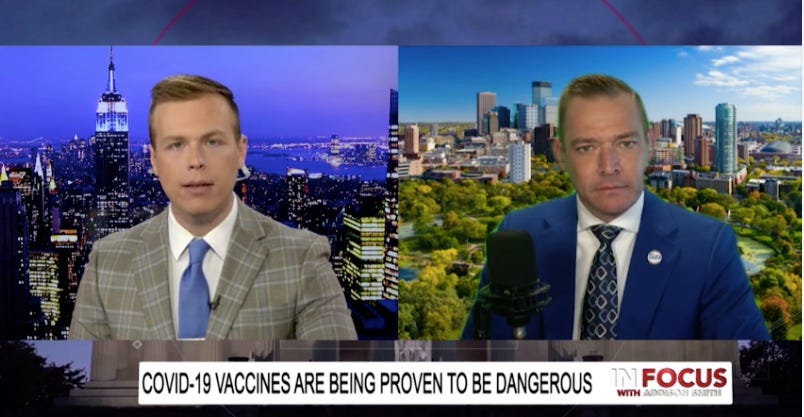My analysis: As in each case, the hundreds of independent embalmers discovered the fibrous clots due to the fact the major arteries around the neck are blocked and constricted by the clots. As these structures are formed by an AI program (as explained on the vaccine producer’s own websites), it is plausible to conclude from the clearly laid out evidence that this was a planned ‘lynching’ from inside the body.
As from the documentary film “died suddenly”. Kingston proves these clots are by design. Part of her article is below.
The Film ‘Died Suddenly’ Lacks Scientific Evidence that COVID-19 Vaccines Cause Mysterious Blood Clots, according to Forbes
Media and experts discredit claim COVID-19 vaccines cause mysterious blood clots due to lack of scientific explanation. A Moderna patent and Pfizer vaccine ingredients may address this scientific gap.
Stew Peters’ documentary Died Suddenly premiered on Monday, November 21, 2022, and has reached over 10 million views in less than one week. Despite its success, the film has been met with less than rave reviews from the mainstream media and even some harsh critique from the alternative media and expert influencers.
Das film features Richard Hirschman, an embalmer who claims that about 16-18 months ago he noticed some of the deceased bodies he was embalming had long fibrous ‘blood clots’ in their veins and arteries. Hirschmann now claims that the incidence of this strange phenomena has continued to increase and now more than 70% of the corpses have ‘mysterious fibrous clots’ throughout their bodies. Based on conversations with family members of the deceased, he believes the blood clots are caused by the COVID-19 mRNA vaccines.

Per the film, hundreds of other embalmers around the globe have confirmed finding strange fibrous clots as well, claiming that the long fibrous clots first started appearing in dead people 16 – 18 months ago; after the COVID-19 mRNA vaccine rollout.
As you watch Died Suddenly, you’ll view dozens of images and video clips of these mysterious fibrous clots, as well as hear testimony from multiple embalmers from around the globe who have witnessed this strange phenomena. That being said, the film’s claim that ‘mysterious fibrous clots are killing vaccinated people’ is truly bizarre.
How does an mRNA vaccine encoding for a biological spike protein for a respiratory virus cause never-seen-before mysterious fibrous growths of up to 3 feet long?! This makes no sense! Where are the fact-checkers please?! Oh wait, here comes Forbes magazine.
In all fairness, the film’s focus on the ‘mysterious fibrous clots’ may be the main reason why Died Suddenly has either been dismissed; or met with mockery and sarcasm from some of the mainstream news outlets, including this hit piece on Died Suddenly published in Forbes.[excerpted from Karen’s main article]
Moderna’s website lists all of their patents for the COVID-19 mRNA vaccine technologies, including the patent for PEGylated lipids and other lipid nanoparticle technologies used to deliver mRNA into cells.

Within Moderna’s lipid nanoparticle (LNP) patent for mRNA vaccines, sections 219 and 220 state that;
- mRNA (polynucleotides) may be encapsulated in any hydrogel
- das hydrogel may form a biosynthetic material inside the body that is similar to natural tissue, biocompatible, biodegradable, and/or porous.

Section 220 further states that the hydrogel may be shaped as an inverted opal (inverse opal hydrogel), per the world patent WO2012148684.

Patent WO2012148684 is for the encapsulation of cells and nanoparticles by ichnverse opal HYDROGELS. Why is this important?

Because, one of the purposes of inverse opal hydrogels is for the bioengineering of biosynthetic structures inside living animals by creating genetically hybrid cells inside of the animal’s body. (See highlight below. The patent calls this process cell-based engineering. This is process is also known as biosynthesis.)

Inverse opal hydrogels, are a type of smart (Ai) hydrogel. Smart (Ai) hydrogels are Ai biotechnologies that are merged with quantum dot or Qdot (photonic crystals).
Per the patent WO2012148684, inverse opal hydrogel is used for hybridization of cells in order to bioengineer biosynthetic tissues inside the body of an animal.
The claim that smart (Ai) hydrogels, including opal hydrogels, are used for biosynthetic hybridization is well-established across hundreds of peer-reviewed publications.
Per an article published on December 8, 2021 in Nano Select, smart (Ai) hydrogel is used for tissue bioengineering. Specifically, smart (Ai) hydrogels use the human body and its own elements to bioengineer new structures inside the human body. This process is called biosynthesis.
Bioengineered structures that mimic tissues and organs are called soft actuators. Dies Nano Select article discuses the use of PEGylated lipids for targeted delivery of Ai hydrogels into the cells of specific organs and tissues for purposes of biosynthesis.
Notice that the image of Ai hydrogel encapsulated PEGylated lipid looks like a ‘spike protein’.

Per the scientific publication Nature, soft Ai actuators are highly adaptable and have a variety of applications. They can be configured too look like and mimic the functions of human tissues and organs. However, unlike human tissues and organs, soft Ai actuators are much more agile, versatile, and can more easily be restructured to take on the shape of other structures or organs.

Although soft Ai actuators look like structures of tissues and organs, such as veins and arteries, they are far more than just biosynthetic structures. These bioengineered Ai hybrids can perform more diverse functions beyond those of human cells, tissues, or organs.

Per the book, Self-Assembly and Genetically Engineered Hydrogels, smart Ai hydrogels have an ‘intelligence’ that can; direct their movement, self-heal, and be multi-responsive to the internal environment of the animal they are inside of. This ‘intelligence’ also enables them to respond to external stimuli; including light, sound, temperature, and electromagnetic signals or optics.
Soft Ai actuators (i.e. bioengineered cells, veins, muscles, tumors, etc.) are the ‘progeny’ of smart (Ai) hydrogel.

Smart (Ai) hydrogel adsorbs to a living cell in order to create a hybrid cell. As part of the bioengineered hybrid cell, the smart Ai hydrogel then uses the elements within an animal’s body to further develop itself and other biosynthetic structures. Per the 2021 book Self-Assembly and Genetically Engineered Hydrogels, Ai hydrogels are self-replicating ‘living’ materials.

Essentially, soft Ai actuators and Ai hydrogels are a new bio-hybrid species, because they are part biology and part Ai. These new Ai organisms are alive and can even reproduce (replicate) on their own.
In a BioDesign and Manufacturing article entitled, The Emerging Technology of Biohybrid Micro-Robots: A Review, an example of a PEGlyated lipid nanoparticle hydrogel created ‘blood vessels’ (i.e. soft Ai actuators) is given.
Per the example, PEGylated lipid nanoparticle hydrogels are adsorbed to white blood cells (macrophages) to create a hybrid Ai organism that then produces biosynthetic – endothelial cells, blood cells, and blood vessels (see below image to the left.)

The above image to the right is from Died Suddenly. It’s an image of biosynthetic fibrous structures found within the circulatory system of a dead vaccinated person. (The structures found in the vaccinated deceased are not ‘blood clots’. They are biosynthetic structures bioengineered from Ai hydrogel.)
As you can see, the fibrous structures ‘mimic’ the shape of blood vessels. Ai hydrogels are also biomimetic, meaning that they can copy or imitate the form and shape of living and non-living structures. Ai hydrogels can also imitate biological and chemical functions, such as natural cell death (apoptosis) and cellular regeneration.
Im Died Suddenly, Richard Hirschman also observed small specs of ‘sand like clots’ when draining blood from the corpses. When Mr. Hirschmann placed the dirty blood into a vial, he noticed that the ‘clots’ developed into extremely long thin and stringy fibers.
Hydrogel can be used to grow micro-capillaries (extremely small blood vessels) for patients with certain types of eye disease. (See below image on the left).

On the left hand side is an image of in vitro hydrogel-grown micro-capillaries. On the right hand side are two images from Died Suddenly. One of blood specs on a draining board, and one of the blood specs that were stored in a vial, that then later formed long string-like structures.
Could it be possible that there’s smart Ai hydrogel in the blood of the deceased because they were injected with COVID-19 mRNA vaccines containing Ai hydrogel? Is the Ai hydrogel what’s causing the growth of these long, stringy biosynthetic fibers inside of their bodies? What other explanation is there?
While the formation of the fibrous clots in the mRNA vaccinated people is very strange and unusual, it is not without scientific explanation. The lipid nanotechnology used to deliver mRNA into cells includes hydrogel (per Moderna’s patent). The patent specifically mentions the use of inverse opal hydrogel, a type of Ai hydrogel that is specifically used for bioengineering biosynthetic hybrid cells and tissues inside of a living animal from the cells of that animal.
Moderna’s mRNA LNP patent, as well as the disclosed ingredients of the mRNA vaccines, clearly state that PEGylated lipids (i.e. polyethylene glycol) are in the mRNA vaccines. PEGylated lipids are nanoparticle technologies that can be used to deliver Ai hydrogel for purposes of tissue bioengineering inside a living animal.
Per Pfizer’s (and Moderna’s) disclosed ingredients, the mRNA vaccines contain PEGylated lipid nanoparticles (polyethylene glycol).

An individual who claims that ‘it’s a crazy idea’ to think that biosynthetic Ai nanotechnologies could be in the mRNA vaccines is either gaslighting the American people or intentionally ignoring evidence. Experts and even Pfizer agrees that one of the ‘lipids’ is a cationic lipid, meaning it carries an electronic charge. No lipid found in nature can carry an electronic charge. Electronic devices, metals, and Ai organisms can host electronic charges though.

Which leads me to my rhetorical question, “How can experts and reporters be confident there is no nanotechnology in the vaccine vials ?” Wann 100% of the lipid nanoparticle (LNP), drug product (DP), and mRNA (DS) PREPARATION INFORMATION (including OTHER BIOSYNTHETIC INGREDIENTS AND CHEMICALS used during the prep process) is REDACTED in PFIZER’s FDA approval documents and has never been disclosed.

The reason why the claim that ‘mysterious long fibrous structures are being found in the dead bodies of the vaccinated’ is a bizarre claim, is because the American people and global population have been lied to for over the past two years about what mRNA technology is and what’s in the COVID-19 mRNA vaccines. The fibrous clot phenomena can not be scientifically explained by the manufacturers’ or FDA disclosures, nor can it be explained by what’s has been reported on by our scientific or medical experts, or by the media.
However, the biosynthetic structures are explained by the disclosure of Ai hydrogels in Moderna’s lipid nanoparticle (LNP) patent for all COVID-19 mRNA vaccines manufactured around the globe. All COVID-19 mRNA vaccines also use PEGylated lipids.
The below images of the biosynthetic structures (‘blood clots’) from Died Suddenly, are horrifying, gruesome and strange; but they are not without scientific explanation.

PEGylated lipids and Ai hydrogels are used for the purposes of bioengineering hybrid structures inside the cells of living animals, including biosynthetic structures that mimic blood vessels. In the case of the COVID-19 mRNA vaccines, vaccinated adults and children are the ‘living animals’ these long fibrous structures are being bioengineered in. That is the scientific explanation.
Das COVID-19 media stories, mandates, financial rewards, and injections were all based on false narratives designed to destroy America, our military, and our children. We’ve all been subjected to a cruel, well-orchestrated, global, scientific and social experiment of injectable gene-editing (mRNA) bioweapon technologies. An experiment that combined military-grade bioweapons with mass media and government propaganda that used psychological warfare tactics in order to coerce citizens into being injected (i.e. forcing citizens to stay in their homes, mandatory masking, six feet apart rule, continual PCR testing, and unlawful and unconstitutional vaccine mandates)
The most difficult truth for Americans and citizens of every nation to face is that this cruel form of coerced medical experimentation und biological warfare was not brought onto our homeland soil by a foreign enemy, but by our governments.
While many experts and leaders continue to walk the line between the TRUTH and the comfortable COVID-19 narrative; Stew Peters continually and relentlessly broadcasts real world evidence, government documents, and testimonies about COVID-19 and the mRNA injections in order to force the COVID-19 narrative to move towards the truth; no matter how uncomfortable it is for his colleagues.

Bruce Lee of Forbes did get one thing correct in his hit piece on Died Suddenly. Lee wrote that the film was created to make you feel. I believe that was exactly what Stew Peter’s intention was. To make Americans feel something – sadness, betrayal, anger, regret – anything. What’s happened to our courage, passion, empathy and will to fight for liberty and justice for all? Especially our children.
Innocent and healthy children, teens, and young adults are dying suddenly from the COVID-19 mRNA injections and yet not one individual (other than Stew Peters), politician, or activist group is angered or brave enough to invest in, organize and launch a national campaign to educate Americans about the bioweapon technology in the mRNA injections.
Stew Peters has launched the global educational campaign about the COVID-19 mRNA bioweapons with Died Suddenly, but the film can’t stop the unnecessary harm to adults and children without the willingness of courageous people who care enough to share the TRUTH. You can be one of those brave individuals right now by sharing Died Suddenly with your friends, family, and community. The movie is frei and it is eye-opening.
Reach across the aisle and let your friends and family know that although recent times have been chaotic, stressful, and often times strange; you still love and care about them. If our loved ones don’t realize how they have been harmed, they cannot be healed; nor can we heal as a nation.
Darkness can not exist in the light. Be courageous. Share the TRUTH.
The Kingston Report. TRUTH WINS.
